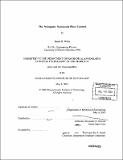The Nanogate : nanoscale flow control
Author(s)
White, James R. (James Robert), 1976-
DownloadFull printable version (10.73Mb)
Alternative title
Nanoscale flow control
Other Contributors
Massachusetts Institute of Technology. Dept. of Mechanical Engineering.
Advisor
Alexander H. Slocum.
Terms of use
Metadata
Show full item recordAbstract
The handling of extremely small samples of gases and liquids has long been a subject of research among biologists, chemists and engineers. A few scientific instruments, notably the atomic force microscope and the surface forces apparatus, have been used extensively to investigate very short range molecular phenomena. In this thesis, the design, fabrication and characterization of a novel gas and liquid flow control device called the Nanogate is described. The Nanogate controls liquid flows under very high confinement, wherein the liquid film is, in one dimension, on the scale of nanometers, but is on the scale of hundreds of microns in its other dimensions. The film thickness can be controlled within two Angstroms. Control of helium gas flow rates in the 10-9 atm.cc/s range, and sub-nl/s flow rates of water and methanol have been theoretically predicted and experimentally verified. However, these results do not reflect the ultimate limits of the current device, but rather the limitations of the test apparatus. It is predicted that control of flow rates two orders of magnitude smaller can ultimately be achieved. The Nanogate has been successfully produced using standard MEMS techniques. This parallel fabrication process lays the foundation for mass-produced scientific instruments based on the Nanogate. Applications in ultra-fine flow control, gas and liquid separations, and a broad range of experiments with highly confined liquid systems can now be envisioned.
Description
Thesis (Ph. D.)--Massachusetts Institute of Technology, Dept. of Mechanical Engineering, 2003. Includes bibliographical references (p. 113-114).
Date issued
2003Department
Massachusetts Institute of Technology. Department of Mechanical EngineeringPublisher
Massachusetts Institute of Technology
Keywords
Mechanical Engineering.